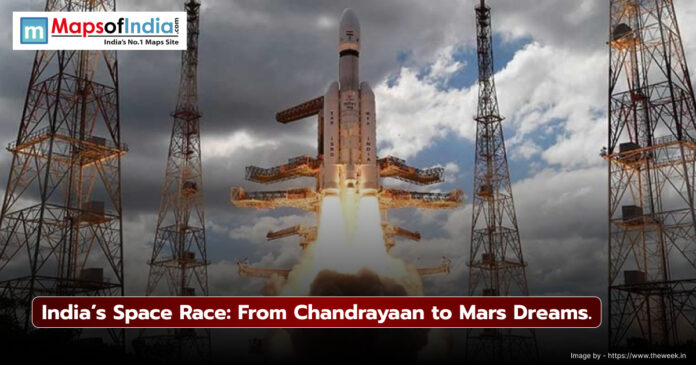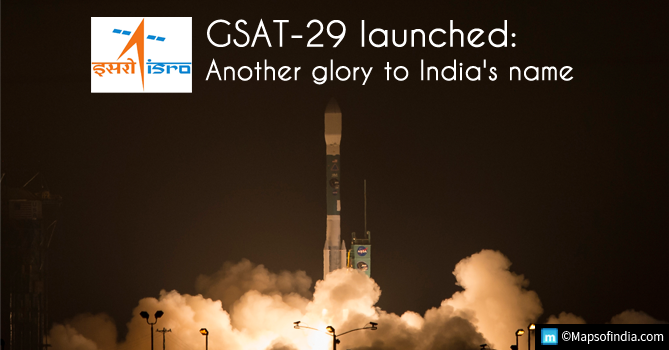The space journey of India is filled with ambitions. It’s a story of ambition. This started with the beginning of modest rockets in the 1960s. Now, we have reached the Moon and Mars. The Indian Space Research Organisation (ISRO) drives this progress to the heights of the world. In recent years, India has planned crewed missions and interplanetary exploration. According to the recent Lumikai report, the space sector in India is valued at Rs. 16000 crore. The ambitious Indian space program Chandrayaan-1 found lunar water. Mangalyaan orbited Mars on its first try. These feats inspire globally.
Origins and ISRO’s Early Vision
The space program was started in 1962. The greatest minds of India, Vikram Sarabha, founded INCOSPAR, which is known as ISRO’s precursor. He is known across the world as the visionary behind India’s space dream who made it come true. India’s first rocket was launched from Thumba in 1963. This rocket was aimed at studying the upper atmosphere. For the first launch, India had to collaborate with well-established foreign space agencies. Aryabhata is India’s first satellite, which was launched in 1975 with the help of the Soviet Union. That satellite weighed 360 kg and was aimed at studying cosmic rays. That was a success. After that, Bhaskara-1 in 1979, added Earth imaging. According to the reports, early budgets for the space programmes were Rs. 10 crore. In the 1980s, India launched Rohini RS-1. It orbited via SLV-3 in 1980. These steps built a self-reliant indian space programme. India joined the global space race and soon emerged as a giant.
Satellite Technology and Launch Vehicles
As time progressed, ISRO excelled in satellite launches. The satellite INSAT-1A, which was launched in 1982, revolutionized the telecom sector. That satellite enabled the launch of a nationwide TV network. For remote sensing purposes, IRS-1A was launched in 1988. It mapped floods and crops across India. IRS has done praiseworthy work in disaster response. The Polar Satellite Launch Vehicle (PSLV) came into India in 1993. To date, India has launched a total of 55 PSLVs. The Geosynchronous Satellite Launch Vehicle (GSLV) soon became part of India’s space programme in 2001. GSLV-Mk III in 2017 carried 4-ton satellites, according to the ISRO fact sheet lists 15 GSLV missions. The Reusable Launch Vehicle (RLV-TD) started testing in 2016. Use of these vehicles can help to cut the costs of space programmes by 30%. These vehicles serve global clients. They mark India’s tech prowess.
Chandrayaan Missions: Lunar Breakthroughs
The most ambitious Indian space programme, Chandrayaan-1, was launched in 2008. This mission successfully discovered water molecules on the Moon’s surface. Again, India planned to land on the moon with Chandrayaan-2 in 2019, aimed for a soft landing. The orbiter succeeded, but the Vikram lander crashed. And it became a failed attempt, but space scientists in India learned from it. With the new passion, India launched Chandrayaan-3, which made history on August 23, 2023. This mission landed softly near the lunar south pole. And made India the first country to do so. An ISRO update says Pragyan rover found sulfur. The mission cost the Indian space programme was Rs. 615 crore. This mission turned out to be a global feat. India is planning the future Chandrayaan-4 plans a sample return by 2027. According ot the VIF India article, this mission will target lunar resources. These missions elevate India’s lunar legacy.
Mangalyaan: Mars on a Budget
To conquer Mars in the global space race, India launched Mangalyaan on November 5, 2013. This satellite entered the orbit of Mars on September 24, 2014. With this, India became the first country to succeed on its debut on Mars. This program cost India $74 million, less than the budget of a Hollywood movie, making it the cheapest Mars mission. That satellite carried a 450 kg payload. That satellite studied Mars’ atmosphere and surface. A ScienceDirect article by Rao says it detected methane. The orbiter launched on Mars ran for 8 years before losing contact with ISRO. India is set for its next Mars mission, planning to launch Mangalyaan-2 in 2026. This will include a rover and an orbiter. According to the recent PIB release, a Rs. 1200 crore budget has been confirmed. Mangalyaan showcased India’s frugal engineering.
Gaganyaan: Human Spaceflight Ambitions
The most ambitious and long-dreamed space project of India, Gaganyaan, is aimed at sending humans to space. This mission was announced in 2018, and it targets a 2025 launch. According to the 2025 ISRO timeline, this mission plans three astronauts for a 7-day orbit. The vehicle GSLV-Mk III will carry the space crew module. According to The Hindu article four, IAF pilots were being trained in Russia. They completed their space training in 2020. Unmanned tests started in 2024. An ISRO report notes that Vyommitra, a humanoid robot, tested systems to send on this mission. It monitors oxygen levels. According to the Economic Times article, the budget allotted for this mission is Rs. 9000 crore. Safety systems include crew escape. This mission is being called India’s boldest mission on a global level. Gaganyaan will make India the fourth nation with human spaceflight.
Challenges and Resilience
India’s space race has faced many obstacles over the period of time. Early SLV launches failed from 1979 to 1981. At the beginning stages, India was lagging behind other countries in many aspects, including resources and money. The Indian space programme also faced many setbacks, like Chandrayaan-2’s lander crash in 2019 was a setback. Budgets for the space programme in India are very tight. ISRO’s 2025 funding is Rs. 13043 crore. This funding is nearly 0.2% of the nation’s GDP. Post-1998 nuclear test sanctions delayed tech transfers. COVID-19 delayed Gaganyaan by two years. Having talented youngsters in the space programme is also difficult. Talent retention is tough. More than 10% of engineers migrate. ISRO’s persistence overcomes hurdles.
Future Horizons and Global Impact
To achieve the greatest space vision of India is expansive. Aditya-L1, which was launched in 2023, is aiming to study the Sun. This will reach the L1 point in 2024. Shukrayaan-1 targets Venus in 2028. This satellite will study atmospheric chemistry. This can turn out to be India’s next frontier. A lunar base is planned by 2040. NISAR, a NASA-ISRO mission, launched in 2024. That satellite will help to map earthquakes. A space station is eyed for 2035. Private firms like Skyroot launch satellites. In India, there are more than 40 startups related to space. India targets 5% of the $400 billion global space market.





